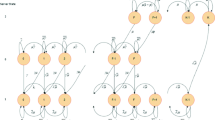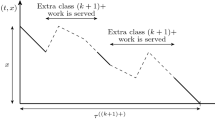Abstract
Motivated by dynamic scheduling control for queueing networks, Chen and Yao [8] developed a systematic method to generate dynamic scheduling control policies for a fluid network, a simple and highly aggregated model that approximates the queueing network. This study addresses the question of how good these fluid policies are as heuristic scheduling policies for queueing networks. Using simulation on some examples these heuristic policies are compared with traditional simple scheduling rules. The results show that the heuristic policies perform at least comparably to classical priority rules, regardless of the assumptions made about the traffic intensities and the arrival and service time distributions. However, they are certainly not always the best and, even when they are, the improvement is seldom dramatic. The comparative advantage of these policies may lie in their application to nonstationary situations such as might occur with unreliable machines or nonstationary demand patterns.
Similar content being viewed by others
References
D. Bertsimas, I.Ch. Paschalidis and J.N. Tsitsiklis, Optimisation of multiclass queueing networks: Polyhedral and nonlinear characterizations of achievable performance, Working Paper of the Operations Research Center, MIT (1992).
G.R. Bitran and D. Tirupati, Multiproduct queueing networks with deterministic routing: Decomposition approach and the notion of interference, Manag. Sci. 34 (1988) 75–100.
J.A. Buzacott and J.G. Shantikumar,Stochastic Models of Manufacturing Systems (PrenticeHall, New Jersey, 1992).
H. Chen, Optimal intensity control of a multi-class queue, Queueing Systems 5 (1989) 281–294.
H. Chen, J.M. Harrison, A. Mandelbaum, A. van Ackere and L. Wein, Empirical evaluation of a queueing network model for semiconductor wafer fabrication, Oper. Res. 36 (1988) 202–215.
H. Chen and A. Mandelbaum, Discrete flow networks: bottleneck analysis and fluid approximations, Math. Oper. Res. 16 (1991) 408–446.
H. Chen, P. Yang and D.D. Yao, Control and scheduling in a two-station queueing network: optimal policies and heuristics, to appear in Queueing Systems.
H. Chen and D.D. Yao, Dynamic scheduling of a multi-class fluid network, Oper. Res. 41 (1993) 1104–1115.
D. Connors, G. Feigin and D.D. Yao, Scheduling semiconductor lines using a fluid network model, submitted to IEEE Trans. Robotics Autom., Special Section on Computer Integrated Manufacturing.
D. Cox and W. Smith,Queues (Methuen, London, 1961).
G. Feigin, Comparing scheduling policies for semiconductor manufacturing, presented atWorkshop on Hierarchical Control for Real-time Scheduling of Manufacturing Systems, Lincoln, New Hampshire (1992).
J.M. Harrison, Dynamic scheduling of a multiclass queue: discount optimality, Oper. Res. 23 (1975) 270–282.
J.M. Harrison and V. Nyugen, The QNET method for two-moment analysis of open queueing networks, Queueing Systems 6 (1990) 1–32.
J.M. Harrison and L.W. Wein, Scheduling networks of queues: heavy traffic analysis of a simple open network, Queueing Systems 5 (1989) 265–280.
L. Kleinrock,Queueing Systems, Vol. II: Computer Applications (Wiley, 1976).
G.P. Klimov, Time sharing service systems I, Theor. Prob. Appl. 19 (1974) 532–551.
P.R. Kumar, Re-entrant lines, Queueing Systems 13 (1993) 87.
T.L. Lai and Z. Ying, Open bandit problems and optimal scheduling of queueing networks, Adv. Appl. Prob. 20 (1988) 447–472.
G.F. Newell,Applications of Queueing Theory (Chapman and Hall, 1982).
S.S. Panwalkar and W. Iskander, A survey of scheduling rules, Oper. Res. 25 (1977) 45–61.
J. Perkins and P.R. Kumar, Stable, distributed, real-time scheduling of flexible manufacturing/ assembly/disassembly systems, IEEE Trans. Autom. Contr. 34 (1989) 139–148.
K.W. Ross and D.D. Yao, Optimal dynamic scheduling in Jackson networks, IEEE Trans. Autom. Contr. 34 (1989) 47–53.
S. Stidham, Scheduling, routing and flow control in stochastic networks,Stochastic Differential Systems, Stochastic Control Theory and Applications, eds. W. Fleming and P.L. Lions, IMA Vol. 10 (Springer, New York, 1988).
J.J. Solberg, A mathematical model of computerized manufacturing systems,Proc. 4th Int. Conf. Prod. Res., Tokyo, Japan (1977).
R. Suri, J.L. Sanders and M. Kamath, Performance evaluation of production networks,Logistics of Production and Inventory, Handbooks in OR and MS, Vol. 4, eds. S.C. Graves et al. (North-Holland, Amsterdam, 1993).
D.W. Tcha and S.R. Pliska, Optimal control of single-server queueing networks and multi-classM/G/1 queues with feedback, Oper. Res. 25 (1977) 248–258.
P.P. Varaiya, J. Walrand and C. Buyukkoc, Extensions of the multi-armed bandit problem: the discounted case, IEEE Trans. Autom. Contr. 30 (1985) 426–439.
L. Wein, Scheduling networks of queues: heavy traffic analysis of a two-station network with controllable inputs, Oper. Res. 38 (1990) 1065–1078.
W. Whitt, The queueing network analyzer, Bell Syst. Tech. J. 62 (1983) 2779–2815.
P. Whittle,Optimization over Time, Vol. I (Wiley, New York, 1982).
P. Yang, Pathwise solutions for a class of linear stochastic systems, Ph.D. Dissertation, Department of Operations Research, Stanford University (1988).
Author information
Authors and Affiliations
Rights and permissions
About this article
Cite this article
Atkins, D., Chen, H. Performance evaluation of scheduling control of queueing networks: Fluid model heuristics. Queueing Syst 21, 391–413 (1995). https://doi.org/10.1007/BF01149168
Received:
Revised:
Issue Date:
DOI: https://doi.org/10.1007/BF01149168




